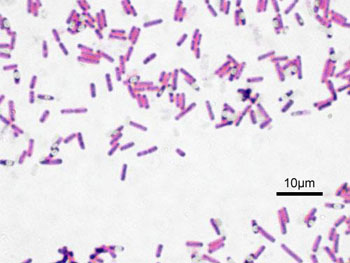Bacterial Cytological Profiling Streamlines Search for New Antibiotics
By LabMedica International staff writers
Posted on 22 Dec 2015
Bacterial cytological profiling is a rapid screening technique for identifying and characterizing new antibiotic compounds from mixtures of natural products.Posted on 22 Dec 2015
Although most clinically used antibiotics are derived from natural products, identifying new antibacterial molecules from natural product extracts is difficult due to the complexity of these extracts and the limited tools to correlate biological activity with specific molecules.

Image: Gram-stained Bacillus subtilis bacteria (Photo courtesy of Wikimedia Commons).
Investigators at the University of California, San Diego (USA) have demonstrated that bacterial cytological profiling (BCP) was a rapid method for determining mechanism of antibiotic action on plates and in complex natural product extracts and for activity-guided purification.
They reported in the December 9, 2015, online edition of the Journal of Antibiotics that they had prepared an extract from Bacillus subtilis 3610 that killed the Escherichia coli lptD mutant and that they had used BCP to observe two types of bioactivities in the unfractionated extract: inhibition of translation and permeablization of the cytoplasmic membrane.
The investigators used BCP to guide purification of the molecules responsible for each activity, identifying the translation inhibitors bacillaene and bacillaene B (glycosylated bacillaene) and demonstrating that two molecules contributed to cell permeabilitization, the bacteriocin subtilosin and the cyclic peptide sporulation killing factor.
The investigators also showed that BCP could be used to screen strains on an agar plate without the need for extract preparation, greatly saving time and improving throughput.
"We have now shown that our method is a powerful way to identify antibiotics from natural products and understand how they work before they are ever purified, potentially shaving years off of screening efforts by identifying which organisms and growth conditions produce interesting bioactive molecules," said senior author Dr. Kit Pogliano, professor of biology at the University of California, San Diego. "This method is a powerful tool for identifying new compounds from sources of natural products that kill bacteria and for determining how they work. Some bacteria have evolved resistance to every known class of antibiotic and, when these multidrug resistant bacteria cause an infection, they are nearly impossible to treat. There is an urgent need for new antibiotics capable of treating infections caused by antibiotic resistant bacteria. With our new method, we can determine which strain is producing an interesting activity and then follow that specific activity during purification to make sure we purify the right molecule. This new approach will help to open up the discovery pipeline, allowing more potential antibiotic producing strains to be rapidly screened for antibiotics that are active against multidrug resistant bacterial pathogens."
Related Links:
University of California, San Diego














